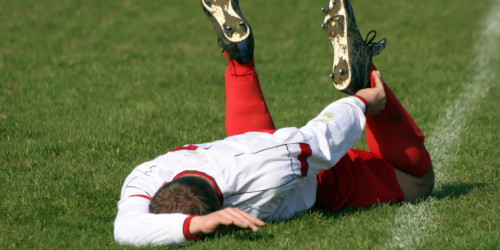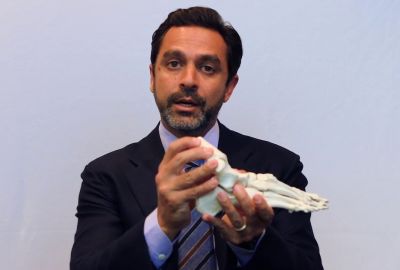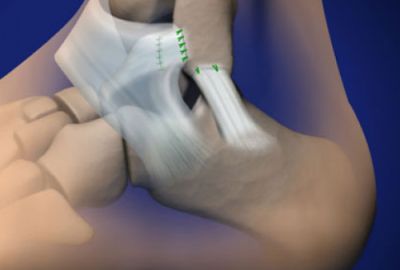- Home
- Foot & Ankle Conditions
- Ankle Sprains and Chronic Ankle Instability
Ankle Sprains and Chronic Ankle Instability
- Published 11/11/2018
- Last Reviewed 3/22/2024
Ankle sprains often occur while participating in sports, walking on uneven surfaces, or just awkwardly planting the foot.
The most frequent type of sprain is called an inversion sprain, which is when the outer ligaments stretch or tear as the foot is rolled outward, with the sole facing in.
Less common is a medial sprain, which is when the foot rolls inward and overstretches the inside ankle ligaments.
- When to see a doctor for an ankle sprain
- What are the symptoms of an ankle sprain?
- How do you diagnose the severity of a sprained ankle?
- What is a high ankle sprain?
- How are ankle sprains treated?
- When ankle sprains turn into chronic ankle instability
- Why partner with UFAI for your ankle treatment?
- Ankle Sprain FAQs
- Should I see an orthopedist or a podiatrist for my sprained ankle?
- Ankle sprain vs ankle fracture, what's the difference?
- How do you prevent ankle sprains?
-
ABFAS® Board Certified in Foot and Ankle Surgery and Co-Director of University Foot and Ankle Institute
Board-Certified Podiatric Foot and Ankle Specialist, Dr. Gary Briskin, DPM, FACFAS, began his medical training by serving a residency at Flint General Hospital in Michigan. Once completed, he established a practice in Century City Hospital, where he soon became chief of podiatric surgery.
Dr. Briskin is a Diplomat of the American Board of Podiatric Surgery and a Fellow of the American College of Foot and Ankle Surgeons. He also serves as an assistant clinical professor at the UCLA School of Medicine and is co-founder and co-director of University Foot and Ankle Institute.
-
ABFAS® Board Certified in Foot Surgery and Reconstructive Rearfoot and Ankle Surgery. and Director of University Foot and Ankle Institute
Dr. Bob Baravarian DPM, FACFAS is a Board-Certified Podiatric Foot and Ankle Specialist. He is an assistant clinical professor at the UCLA School of Medicine and serves as Director of University Foot and Ankle Institute.
Dr. Baravarian has been involved in athletics his entire life and played competitive tennis in high school and college. He has an interest in sports medicine, arthritis therapy, and trauma/reconstructive surgery of the foot and ankle. He is also fluent in five languages (English, French, Spanish, Farsi, and Hebrew),
Read Our Blog Articles About Chronic Ankle Instability
 From scheduling, check-in, visit, and procedure to payment - all went smoothly. The doctor and his assistant were amazing. I go...David A.
From scheduling, check-in, visit, and procedure to payment - all went smoothly. The doctor and his assistant were amazing. I go...David A. Please provide handicap parkingBarry S.
Please provide handicap parkingBarry S. Dr. Ambibola Johnson is awesome!Laurie S.
Dr. Ambibola Johnson is awesome!Laurie S. I appreciate the care and timeliness of all my appointments I’ve had at UFAI. Gray, Lydia and the staff all are wonderful. Lydi...Edelmira G.
I appreciate the care and timeliness of all my appointments I’ve had at UFAI. Gray, Lydia and the staff all are wonderful. Lydi...Edelmira G. Everyone is terrific and helpful at both the Santa Monica and Sherman Oaks offices. Dr. Bob is especially patient with you and...John F.
Everyone is terrific and helpful at both the Santa Monica and Sherman Oaks offices. Dr. Bob is especially patient with you and...John F. Very greatfull for the doctor and stuffJesus M.
Very greatfull for the doctor and stuffJesus M. Doctor was very caringBrigitte S.
Doctor was very caringBrigitte S. Everyone is very nice and efficient-
Everyone is very nice and efficient-
Especially Dr Kelman. He takes very good care of me!!Claudia K. Great costumer service.
Great costumer service.
Prompt and efficientDean W. No . I’m pleased with the care .Michael P.
No . I’m pleased with the care .Michael P. Appreciate the professionalism and expertise, as well as the caring.Stella G.
Appreciate the professionalism and expertise, as well as the caring.Stella G. Love your practice and staff and will continue to refer all of my friends and family. Thank you for taking the time to really e...Bobbie P.
Love your practice and staff and will continue to refer all of my friends and family. Thank you for taking the time to really e...Bobbie P.
-
 Listen Now
Kids’ Feet and Growth Plates: 5 Problems to Watch For
Read More
Listen Now
Kids’ Feet and Growth Plates: 5 Problems to Watch For
Read More
-
 Why Do So Many Pro Athletes Suffer from High Ankle Sprains?
Read More
Why Do So Many Pro Athletes Suffer from High Ankle Sprains?
Read More
-
 Listen Now
7 Causes of Inner Ankle Pain Revealed!
Read More
Listen Now
7 Causes of Inner Ankle Pain Revealed!
Read More
-
 Listen Now
5 Reasons Why You Have Pain on the Outside of Your Foot
Read More
Listen Now
5 Reasons Why You Have Pain on the Outside of Your Foot
Read More
-
 Listen Now
5 Signs your Ankle Sprain Might be a Fracture
Read More
Listen Now
5 Signs your Ankle Sprain Might be a Fracture
Read More













